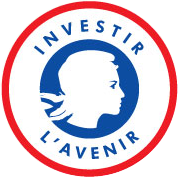
The reversible hydriding on which solid hydrogen storage is based is an exo-thermal reaction associated with a violent change in volume at the crystalline scale. In order to optimise the efficiency and serviceability of the tank during H2 cycling, two key areas need to be addressed
- optimisation of the capacities and kinetics of charging/discharging by optimising heat exchange;
- consideration of respiration (expansion/contraction of the powder bed) and decay (self-fragmentation of the particles), which induce deleterious stresses on the tank walls and therefore limit the geometry that can be used industrially.
To this end, the project proposes the development of simulations and design tools to model the ageing of the confined storage powder, to predict the stresses in the tank, its damage or even its rupture and, above all, to evaluate safe and efficient geometries.
The aim is to guarantee storage performance and safety in a context of increasing complexity of heat exchanger and storage tank geometries.
This project is held by FEMTO-ST and ImViA and is supported by the Bourgogne Franche-Comté region and the National Research Agency (ANR):
One Post-Doctorate positions is opened for this project. To apply please contact directly by email the person in the job file below :
Post-Doctorate Position :




